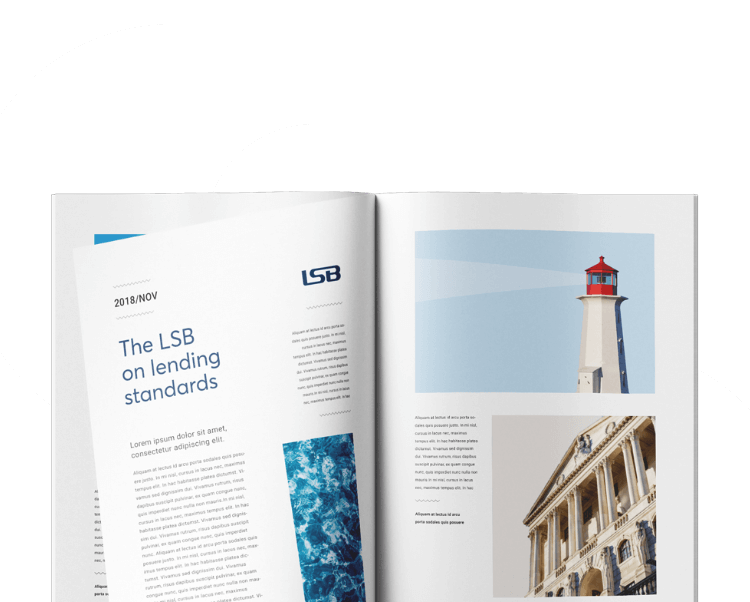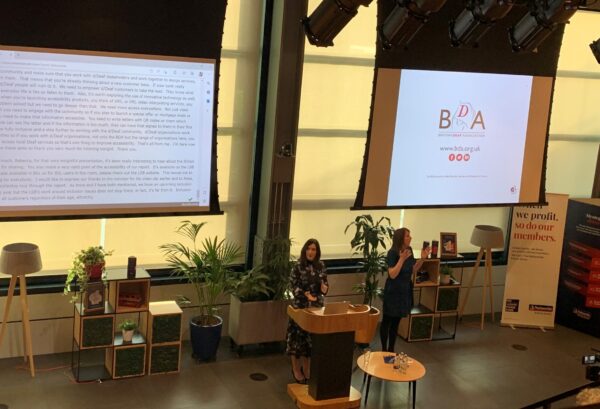LSB Head of Insight and Engagement, Anna Roughley, recently spoke at the Money Advice Liaison Group’s National Members Meeting on the power of prevention in the cost-of-living crisis, including the importance of signposting and empathetic, effective conversations when driving forth fair customer outcomes. You can read her full speech below.

*The notes below may differ from those delivered on the day*
Hello, my name is Anna Roughley and I am the Head of Insight and Engagement at the Lending Standards Board – the LSB. I’m really pleased to be here and to have had the opportunity to have heard from all of the speakers today.
I’m going to talk to you about the power of prevention. What I mean by this is the difference we can make to customers’ lives by focussing on how and when we intervene to prevent them from harm. Whether that is preventing financial difficulty, or preventing additional harm and distress as a result of their personal circumstances. This is particularly important as more customers are exposed to these situations as we leave the pandemic straight into a cost of living crisis.
Prevention won’t unfortunately always mean stopping something from happening, but it may reduce its impact.
As the primary self-regulatory body for the banking and lending industry, the LSB’s independent oversight team oversee the major UK banks, lenders, credit card providers, debt collection agencies and debt purchase firms’ adherence to our Standards and Codes.
We see first hand, across the financial services sector, areas of good practice and areas where development is needed in relation to customer outcomes. We also see the interaction between other sectors where collaboration and development could also improve prevention and deliver greater protection.
Brexit, the pandemic, the war on Ukraine, and now the cost-of-living crisis, have created a perfect storm of challenges within our society and an increase in people experiencing new or heightened personal struggles.
It’s important for firms to consider those they already know to be vulnerable, whilst also recognising those individuals and groups of customers who maybe weren’t, but are now facing real struggles, hardship and perhaps vulnerability for a multitude of reasons.
Although I’m going to concentrate on the unfolding events around cost-of-living crisis due to the major impact on customers, the insight I will share today really relates to practices that are applicable at all times.
I just want to take a moment to recognise that this feels huge. That the pressure is on.
But I also want to say that I know greater prevention is achievable. And it is achievable because we at the LSB see examples of governance and frameworks that encourage and evidence good practice, good intervention, good customer awareness, good conversations and customer interaction and good customer outcomes.
We’ll have some time for questions later on, so please do keep that in mind throughout the session as I’d be happy to answer any you have.
The current landscape
At risk of sounding like a broken record, the last few years have been filled with uncertainty and instability, and the disruption to the UK, and indeed the rest of the world, doesn’t seem to be slowing down. There is an unprecedented level of rising prices and cost uncertainty in a number of sectors, with people having to adapt their budgets and spending on a near monthly basis.
It isn’t just direct spending that is affected, people are taking action to reduce their use of cookers and baths or showers and cutting down on what they deem an unnecessary spend, such as Netflix or Sky packages. Household costs are expected to continue to rise throughout the year.
Those already on the edge of difficulties have nowhere to turn to protect themselves from rising prices. And so many people who would not previously have found themselves in challenging circumstances, may now be at risk and require support and assistance in their day-to-day lives. An example of this is in the collections space where Pay Plan have reported for the first time seeing an increase in clients from households with incomes of £60,000 or more.
I read just earlier this week a report that indicated that less than half of UK households have either no savings at all or not enough to cover a large unexpected expenditure, and the most common step taken by households to ‘make ends meet’ since the start of 2022 was to save less money than usual – with this affecting 51% of households.
We can quickly begin to see how those previously unaffected, may very quickly need help. Firms need to be ready to adapt to these needs, rather than to try and pick up the pieces after.
Preventing customer detriment, improving outcomes
For those of you who are registered to the personal Standards or those familiar with our work, you will know that one of our Standards refers to money management. The Standard sets out that customers should be helped with ‘managing their finances through proactive and reactive measures.’[1] This is more important than ever, because the cost-of-living crisis is only an unknown in as much as who will be impacted, when. It is happening, so we have to be ready to provide the right support at the right time – through intervention and prevention.
This is achieved through a number of methods including ‘proactively encouraging customers’ to get in contact if there has been any change in their circumstances, using the information you have available to identify signs of financial stress and training your teams to spot and be aware of potential difficulties, and responding positively and proactively with customers so you can help to prevent the impact of the crisis or their circumstance from developing or worsening.
Before we delve into these a little further I would like to introduce a poll we have today – its completely anonymous, but really straight forward to use – I hope.
I have three questions I would like to gain some insight from you on. If you scan this QR code, or use accessible software it should launch an app called Slido and present you with your first question:
Do you think financial service providers are ready to support customers with the cost-of-living crisis?
We will use this information to contribute to a piece of work we will publish shortly which talks about how we support customers better in pre-arrears, offering best practice support and challenges we see. But whilst you are all busy responding to that I will continue.
I mentioned encouraging proactive customer contact. Very often customers are not aware of the support available to them before they need it, or understand why sharing that information may be important. Engaging and informative customer communications play an important part in this. It is important that customer information on letters, apps, websites, and other channels is reviewed to ensure they mention and address the cost-of-living crisis and that the information is easily accessible.
Another example of this, outside of money management, is around scam awareness. The primary purpose of scam education is to prevent a customer from falling victim to a scam in the first instance, after that messaging focuses on encouraging the customer to contact the payment service provider as soon as possible with as much information as possible, hoping to reduce the impact.
During the pandemic we saw good examples of proactive, relevant and specific scam awareness campaigns and consideration was given to positioning of information and also ease of access. You can see here the importance of encouraging contact when circumstances are expected to change or have changed throughout the cost-of-living crisis. Being informed, or able to find the relevant information swiftly, can be the catalyst for action and better outcomes.
In terms of identifying signs of distress, firms may analyse data or look for patterns that lead them to believe that a certain group of customers may be at an increased risk of entering financial difficulties. A customer may disclose a situation, or provide some information that may indicate they may be or are experiencing difficulties. The challenge is then to either know what to do with this information and how to positively address the concerns, or how to effectively gather enough information, through further probing, to be able to provide the right support.
We know from our work in Emerging Risk Forums for example that some firms have tried proactive contact but not found it to deliver the changes in behaviour or resolutions it set out to. This could be because these conversations can be challenging; for example, contacting customers proactively and explaining concern about overspending/lack of income or some other trigger, or probing further as it could provoke a negative reaction from the customer.
And so we want to ensure that staff have the knowledge, skills, confidence and flexibility to support customers showing signs of or in difficulty. This begins with understanding the various ways the cost-of-living crisis is impacting both personal and business customers. This is a unique crisis and so staff should not be expected to rely purely on training for ‘business as usual’ financial difficulties. In part, this is because of the scale of the crisis and the fact it is affecting so many sectors and elements of people’s lives. In November 2020, we published a piece of qualitative research ‘The meaning of Life Experience’ which reinforces this point really. We interviewed a number of organisations and found that across those contributing, it was thought that the life experience of individuals had a role to play in the experience a customer received.
So it must not be assumed that because the cost-of-living crisis is universal, that all front line employees will be able to understand how customers are impacted and therefore training should be refreshed or new aspects introduced to support these changes. Without considering this, we are at risk of missing key indicators of difficulty and a lost opportunity to intervene and provide support that may have potentially prevented exacerbating the customers situation.
Part of training for those engaging with customers should also involve how to have effective conversations. Active listening and demonstrating empathy are two key components of an effective conversation. They create a connection between an agent and a customer, and when we connect, we can build a relationship and trust, even if it is just for a moment in time. With trust comes openness, and it is through that openness that an agent can really get to the heart of what is happening for the customer and help produce the best outcome for them moving forward.
I mentioned earlier that the insights we would talk about today are not only applicable in the cost-of-living crisis. Lets take a moment to think about problem gambling for example.
Before staff are able to help customers, they must be able to understand what problem gambling is and how to identify signs of it. We can see that the skills required here are relatable to todays cost-of-living crisis. Firstly having an understanding of how the cost of living crisis may impact customers and secondly how to identify the signs.
By training staff on the best way to speak with customers about their circumstances (including problem gambling, a potential vulnerability or financial difficulty), firms are more likely to give staff the confidence to ask pertinent questions when needed. Training should focus on asking open questions and actively listening to the customer. This is empathy in action. Empathy is not a series of phrases in response to the answer a customer has given. Empathy is only felt if demonstrated through action, active listening, the way we respond, and recognising and referring back to what we have already been told. Behaving in this way also gives the agent the opportunity to recognise times when the customer may be omitting important information or may be embarrassed to talk about a subject and normalising it – creating a safe space to talk.
Being live to how customers may be impacted by the current crisis, together with these soft skills, will help agents to properly support customers and deliver better outcomes.
And here is the second question:
Do banks and lenders have enough tools to help customers with this crisis?
Really engaging with the customer and understanding their circumstances enables us to better tailor a solution for them, hopefully stalling their situation, and putting something in place that prevents the situation worsening.
Signposting is an important step in supporting customers when they require help beyond the remit of the firm. This is especially the case now. Firms should look at the support available for customers and ensure the information for both customers and staff is up to date. This includes looking, where possible, at local support that customers could be signposted towards. For example, in the case of food banks or other regional support groups, the help available to customers in Devon will differ from those in Deptford.
The positioning and timing of signposting is also really important if it is to be effective and bring around positive engagement. It should take place at the relevant time in the call, the agent should understand what the organisation does and critically does not do, the customer should be clear on how that organisation can help them with their needs and be given the time to actually engage with the third party.
Firms need to ensure that processes are accurate and reflective of ongoing changes during the crisis. For example, this could include making sure that any guideline expenses are updated as prices change so that whilst engaging with customers your staff have the right information to hand.
When it is difficult to look ahead and estimate what costs will be, such as when making a payment plan, there should be flexibility built in, along with touch points to check in on the customer and see the plan is working and ensure that the preventative action put in place remains fit for purpose and the best solution.
Here’s your last question:
Do banks and lenders understand all the various external support that could be signposted towards?
Scam prevention
You may well be thinking why is scam prevention relevant to me? Hopefully, that will come clear but first some stats for you.
In 2021, there were 345,137 authorised push payments (APP) made to fraudsters – totalling £583.2m. These are really big numbers.
APP scams occur when a customer is tricked into sending money to a person they believe is a legitimate payee, but is in fact a scammer. Now more than ever customers need to feel they can trust their service provider, and there are many things happening that are challenging this, such as APP scams.
Scammers rely on the good relationships that customers have with their providers by impersonating them, and this erodes trust. The more that can be done to prevent scams from happening and trust from further being eroded, the better. Customers need to be confident in the relationship with their providers, because as we have outlined today, trusting relationships are the most open and provide the most opportunity to provide the best outcomes. And for both service providers and customers, the current crisis has never needed that more.
And today we have banks and lenders here? Debt advice? Utility providers? Telecomms? Tech firms? Well then this is relevant to you and your organisation, because we all have a role to play in preventing scams.
And if this still doesn’t resonate with your organisation, then as my personal message of prevention to you as an individual, this is relevant.
That’s because we often think that we are immune to falling for a scam. It wouldn’t happen to me. But in the main, I am sorry to say, we would be wrong.
Anyone can fall victim to an APP scam, and factors such as life events, physical and mental health, caring responsibilities and so on can make us more susceptible to falling for an APP scam. Even the cost of living crisis – and we are all in some way affected by that. Citizens Advice recently revealed that whilst over 55s are most likely to be a target of a scam, people under the age of 34 are actually five times more likely to fall for a scam. And men are apparently twice as likely to fall for a scam than women.
These scams have long lasting impacts on their victims. In fact, recent statistics from Canada Life highlighted that of people they surveyed who had been a victim of an APP scam or who knew someone who had, 37% of people felt like their trust in others had vanished, 47% were left feeling foolish, and 55% said it had taken a toll on their mental health. These feelings don’t go away. Preventing scams from happening in the first place is vital, because it is the only way to truly avoid this customer harm.
We know that scammers see issues such as the cost-of-living crisis as an opportunity – a springboard to exploit innocent people, and in many cases, they then use that money to fund serious and organised crime. Examples are bogus emails claiming to be from Ofgem offering rebates, and impersonating energy companies and creating fake energy bills, offering increased rates of return on investments or special offers on purchases.
Scammers socially engineer their victims to fall for their deceit, by building relationships and trust with them, tapping into accounts to gather information, and hacking phone systems to feign their identity. This means that often by the point the customer comes to make the payment in their bank app, branch or on the telephone, they are already convinced it is legitimate and nothing can break the spell. That is why other organisations must play their part; social media companies preventing scammers from making accounts; phone companies preventing scammers from spoofing phone numbers; and utilities companies preventing customers from falling for impersonation scams. There are so many sectors involved and so many opportunities to intervene.
Early intervention and prevention are paramount to putting a stop to customer harm. And so collaboration is another prevention tool we can use at this time.
We know that collaboration can work really well, a great example of that we have seen in recent years is the use of debt advice and debt support for vulnerable customers and those in financial difficulty. All industries need to, as a matter of urgency, look at the part they play, independently and together, in the scam journey, identifying as many opportunities as possible to intervene. Stop the scam in its tracks. Protect the customer and ensure the scammer is the only one losing out.
In conclusion
Today we have focused on the importance of identifying and responding to customers in and approaching financial difficulty and those whose situations may make them more susceptible to harm.
We have discussed some key areas that require specialised focus on current events like the the cost-of-living crisis; such as training and empowering our agents to understand how the crisis may impact customers, how to use the information available to have more empathetic conversations, refreshing signposting information that is valuable, timely and suited to the customer circumstances, and the strength of collaboration. Many of these intervention and prevention mechanisms are in some form already in place in many organisations.
One thing the pandemic taught us was that we can do more with what we have – and so now is the time to really shine a light on our internal practices and understand where we can do better.
Because, for all, prevention really is the best outcome.
[1] LSB, The Standards of Lending Practice – personal (money management)









